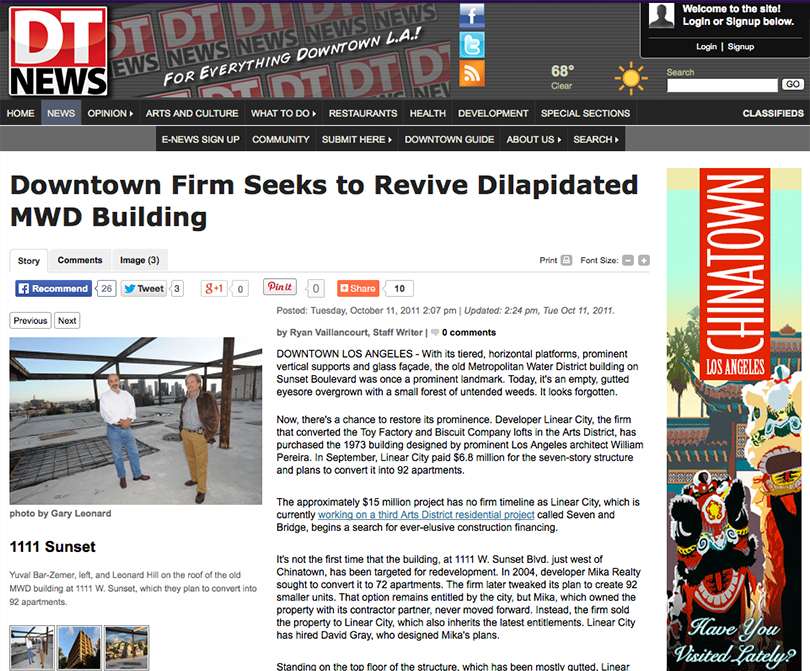Downtown Firm Seeks to Revive Dilapidated MWD Building
DOWNTOWN LOS ANGELES – With its tiered, horizontal platforms, prominent vertical supports and glass façade, the old Metropolitan Water District building on Sunset Boulevard was once a prominent landmark. Today, it’s an empty, gutted eyesore overgrown with a small forest of untended weeds. It looks forgotten.
Now, there’s a chance to restore its prominence. Developer Linear City, the firm that converted the Toy Factory and Biscuit Company lofts in the Arts District, has purchased the 1973 building designed by prominent Los Angeles architect William Pereira. In September, Linear City paid $6.8 million for the seven-story structure and plans to convert it into 92 apartments.
The approximately $15 million project has no firm timeline as Linear City, which is currently working on a third Arts District residential project called Seven and Bridge, begins a search for ever-elusive construction financing.
It’s not the first time that the building, at 1111 W. Sunset Blvd. just west of Chinatown, has been targeted for redevelopment. In 2004, developer Mika Realty sought to convert it to 72 apartments. The firm later tweaked its plan to create 92 smaller units. That option remains entitled by the city, but Mika, which owned the property with its contractor partner, never moved forward. Instead, the firm sold the property to Linear City, which also inherits the latest entitlements. Linear City has hired David Gray, who designed Mika’s plans.
Standing on the top floor of the structure, which has been mostly gutted, Linear City partner Yuval Bar-Zemer looked out the windows, south at the Downtown skyline, which from that vantage made the Hollywood (101) and Harbor (110) freeways appear like a kind of mote around the skyline. To the west and north are the residential neighborhoods of Echo Park and Silver Lake. Chinatown is immediately to the east.
“How could someone neglect this thing for so long?” Bar-Zemer asked.
The edifice was built in 1974 to accommodate a growing Metropolitan Water District, which already occupied a neighboring 100,000-square-foot building that opened in 1963. About two decades after erecting the seven-story tower, the agency again needed more room. It left the Sunset Boulevard campus in 1993, moving to office space at California Plaza for five years while a new headquarters near Union Station was built, said MWD spokesman Bob Muir.
The campus was purchased in 1993 by the Holy Hill Community Church, which later subdivided the property and sold the office tower to an investor who planned a senior housing complex, Bar-Zemer said. That project failed, and the investor sold the building to Mika.
Linear City bought the property in March, but it took six months for the deal to close, as the seller settled some legal complications stemming from a dispute with the church.
Pereira Power
Linear City’s plans to revive the MWD building is welcome news for L.A. design enthusiasts. Although Pereira didn’t work on houses like Richard Neutra or Rudolph Schindler, he was among the most prominent modern architects in Los Angeles in the 1950s and ’60s, said Scott Johnson, a partner in Downtown-based architecture firm Johnson Fain.
“He was known to be an architect of institutional and large scale,” Johnson said. “His career from a client perspective is kind of staggering.”
Pereira’s resume includes being the lead architect on the LAX theme building, the futuristic central pod at the airport; the Los Angeles County Museum of Art; Downtown’s Transamerica Building (now known as the AT&T Center); and the Transamerica pyramid building in San Francisco.
Pereira might never have imagined that his office tower at 1111 W. Sunset would one day be a housing complex. But Pereira was also an urban planner, said Johnson, who suggested that the late architect would probably delight at the reuse of the building to satisfy a changing city fabric.
“That address wouldn’t have been a viable place for people to live 40 years ago – it was an institutional, enclosed campus,” Johnson said. “Now the environment has changed and people think about it differently and they’re in that area now doing different things. Assuming they take the best parts of the building, and use what’s good about it, I think it would be very interesting.”
That is, essentially, the plan, Bar-Zemer said.
Linear City’s proposed adaptations include utilizing the horizontal platforms, which jut out a few feet from the façade at every level. They’ll become balconies. Apartments will measure from 800-1,000 square feet.
Location wise, Bar-Zemer and Linear City partner Leonard Hill see the project as a nexus among several desirable neighborhoods, and a bridge between those areas and Downtown.
“I see taking what has become a very vital and exciting scene in the Silver Lake and Echo Park sections of Sunset and allowing it to continue downstream to that part of Sunset, which is sort of a no-man’s land,” Hill said. “I also believe Chinatown is going to go through a revitalization and this is the logical link between Echo Park and Chinatown.”
For now, Bar-Zemer and Hill are concentrating on financing. The firm is currently paying for the construction of Seven and Bridge, a $5 million, 78-unit apartment complex, out of pocket. Hill said they have the capacity to fund 1111 W. Sunset through private equity, but that they are seeking a bank loan because those are generally less expensive.
So far, however, he said that despite a spate of federal regulations and recent moves by the Federal Reserve to ease credit, banks remain hesitant to fund construction efforts.
View Article at DT News
Writen By Ryan Vaillancourt

